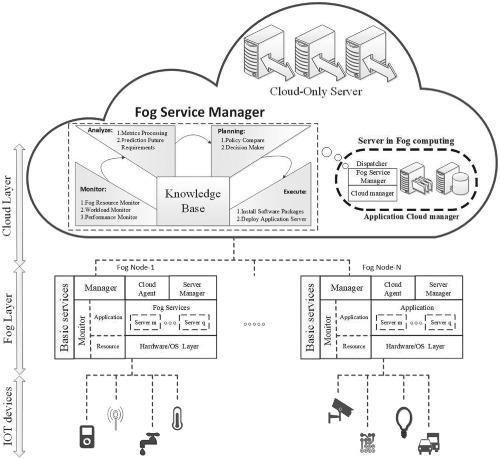当前位置:
X-MOL 学术
›
Int. J. Commun. Syst.
›
论文详情
Our official English website, www.x-mol.net, welcomes your feedback! (Note: you will need to create a separate account there.)
A dynamic fog service provisioning approach for IoT applications
International Journal of Communication Systems ( IF 2.1 ) Pub Date : 2020-07-15 , DOI: 10.1002/dac.4541 Mohammad Faraji Mehmandar 1 , Sam Jabbehdari 1 , Hamid Haj Seyyed Javadi 2
International Journal of Communication Systems ( IF 2.1 ) Pub Date : 2020-07-15 , DOI: 10.1002/dac.4541 Mohammad Faraji Mehmandar 1 , Sam Jabbehdari 1 , Hamid Haj Seyyed Javadi 2
Affiliation

|
Internet of Things (IoT) is an ecosystem that can improve the life quality of humans through smart services, thereby facilitating everyday tasks. Connecting to cloud and utilizing its services are now public and common, and the experts seek to find some ways to complete cloud computing to use it in IoT, which in next decades will make everything online. Fog computing, where the cloud computing expands to the edge of the network, is one way to achieve the objectives of delay reduction, immediate processing, and network congestion. Since IoT devices produce variations of workloads over time, IoT application services will experience traffic trace fluctuations. So knowing about the distribution of future workloads required to handle IoT workload while meeting the QoS constraint. As a result, in the context of fog computing, the main objective of resource management is dynamic resource provisioning such that it avoids the excess or dearth of provisioning. In the present work, we first propose a distributed computing framework for autonomic resource management in the context of fog computing. Then, we provide a customized version of a provisioning system for IoT services based on control MAPE‐k loop. The system makes use of a reinforcement learning technique as decision maker in planning phase and support vector regression technique in analysis phase. At the end, we conduct a family of simulation‐based experiments to assess the performance of our introduced system. The average delay, cost, and delay violation are decreased by 1.95%, 11%, and 5.1%, respectively, compared with existing solutions.
中文翻译:

物联网应用的动态雾服务供应方法
物联网(IoT)是一个生态系统,可以通过智能服务改善人类的生活质量,从而促进日常工作。连接到云并利用其服务现已成为公共和通用的,专家们寻求找到一些方法来完成将云计算用于IoT的过程,在接下来的几十年中,这将使一切都在线。云计算扩展到网络边缘的雾计算是实现减少延迟,立即处理和网络拥塞的目标的一种方法。由于物联网设备会随着时间的推移产生不同的工作负载,因此物联网应用程序服务将遇到流量跟踪波动。因此,了解在满足QoS约束的同时处理IoT工作负载所需的未来工作负载的分布情况。结果,在雾计算的背景下,资源管理的主要目标是动态资源配置,这样可以避免配置过多或不足。在当前的工作中,我们首先提出了一种在雾计算环境下用于自主资源管理的分布式计算框架。然后,我们提供基于控制MAPE-k循环的物联网服务供应系统的定制版本。该系统在计划阶段利用强化学习技术作为决策者,在分析阶段利用支持向量回归技术。最后,我们进行了一系列基于仿真的实验,以评估引入系统的性能。与现有解决方案相比,平均延迟,成本和延迟违规分别降低了1.95%,11%和5.1%。
更新日期:2020-07-15
中文翻译:

物联网应用的动态雾服务供应方法
物联网(IoT)是一个生态系统,可以通过智能服务改善人类的生活质量,从而促进日常工作。连接到云并利用其服务现已成为公共和通用的,专家们寻求找到一些方法来完成将云计算用于IoT的过程,在接下来的几十年中,这将使一切都在线。云计算扩展到网络边缘的雾计算是实现减少延迟,立即处理和网络拥塞的目标的一种方法。由于物联网设备会随着时间的推移产生不同的工作负载,因此物联网应用程序服务将遇到流量跟踪波动。因此,了解在满足QoS约束的同时处理IoT工作负载所需的未来工作负载的分布情况。结果,在雾计算的背景下,资源管理的主要目标是动态资源配置,这样可以避免配置过多或不足。在当前的工作中,我们首先提出了一种在雾计算环境下用于自主资源管理的分布式计算框架。然后,我们提供基于控制MAPE-k循环的物联网服务供应系统的定制版本。该系统在计划阶段利用强化学习技术作为决策者,在分析阶段利用支持向量回归技术。最后,我们进行了一系列基于仿真的实验,以评估引入系统的性能。与现有解决方案相比,平均延迟,成本和延迟违规分别降低了1.95%,11%和5.1%。


























 京公网安备 11010802027423号
京公网安备 11010802027423号